#christmas folklore
Photo
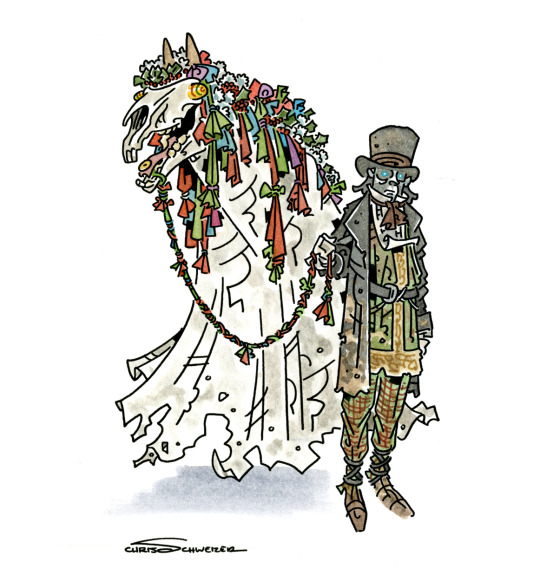
Companions of Christmas 7: Mari Lwyd!
Mari Lwyd was a gray mare belonging to Taliesin, a poet hailed as “chief of the bards” in sixth century Wales. Taliesin frequently called on Awen, the Welsh muse, for inspiration, and Awen became so captivated by his verses that she determined that he would never again leave her cottage and stay with her forever in the forest glades on the edge of the Glamorgan pastureland.
Mari Lwyd, left tethered outside, was no fan of this plan. She was hungry, and thirsty, and if her rider wasn’t to be released to feed and water her, then the least Awen could do was let her into the cottage so that Taliesin could care for her there.
Mari Lwyd, so long the companion of a great poet, had learned to think as a poet thinks, and so, when she called on Awen to let her in, she did so in rhyme. Awen, not wanting her time with Taliesin interrupted, used rhyme in return to refuse her request, and Mari offered a different argument in favor of an invitation, which was likewise refused. Back and forth they went, neither failing to find the proper words, and their exchange went for so long that eventually Mari Lwyd was nothing but bones.
So engaged by the mare’s clever rhymes was she that Awen hadn’t spared a thought to her captive, but, a longing for him suddenly him popping into her head, she turned to him, and saw that he, too, had long become nothing but bones. Awen found herself at a loss for words, and, unable to offer further excuses to bar Mari Lwyd’s entrance, allowed her into the cottage, where the skeletal mare helped herself to the holiday food and drinks that Awen had prepared for her late paramour.
Now, each Christmas Eve, Mari Lwyd roams the roads and byways of Glamorgan, led by the silent ghost of Taliesin, asking, in rhyme, entry into homes which she suspects contain holiday fare for her to eat. As it was with Awen, she can only be kept out by rebuttal to her invitation in rhyme, but should those who would bar her entrance fail to provide a suitable excuse in verse, she and her entourage face no obstacle in entering and turning the home into their own boisterous feasting hall.
1K notes
·
View notes
Photo

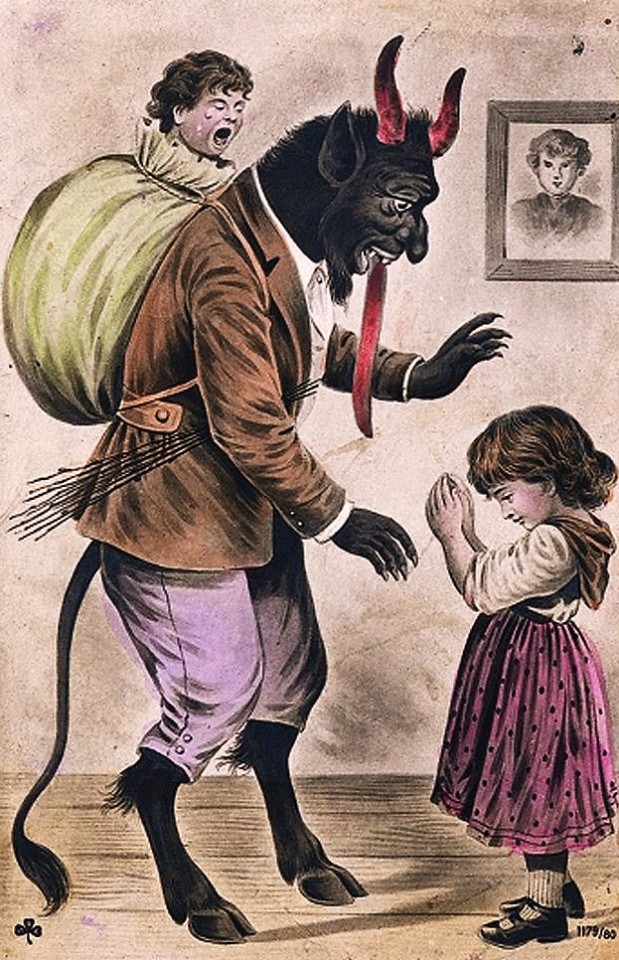

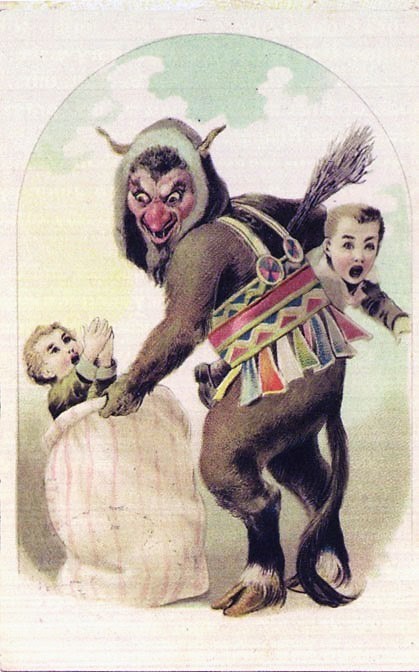
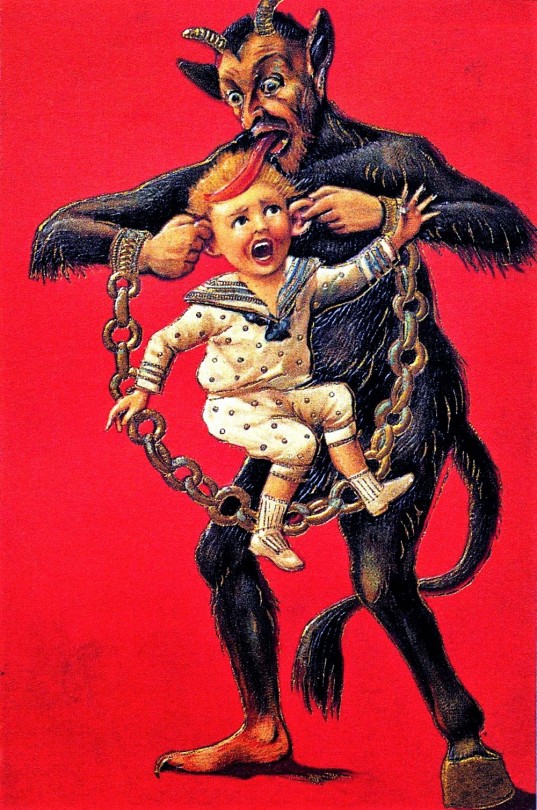
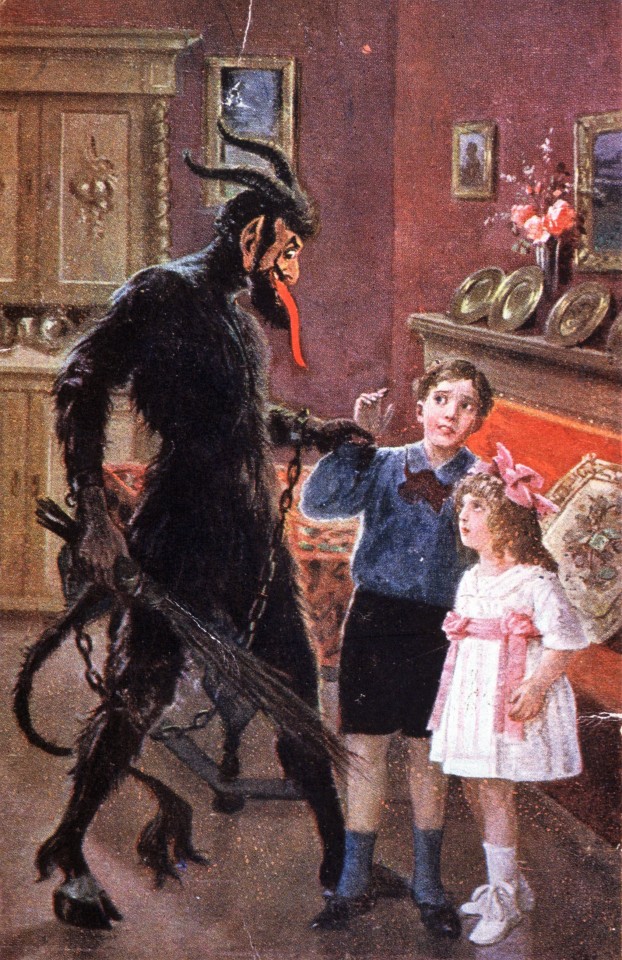

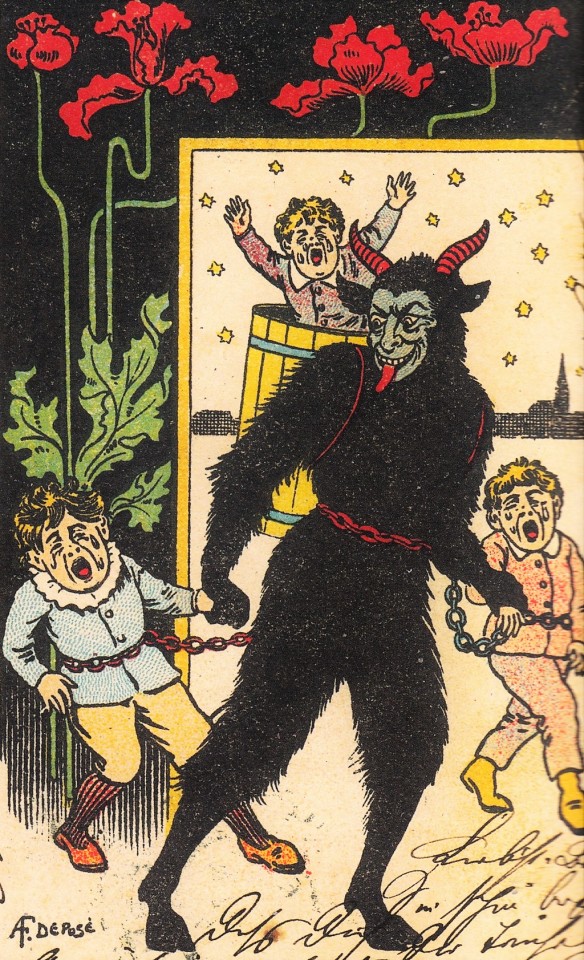
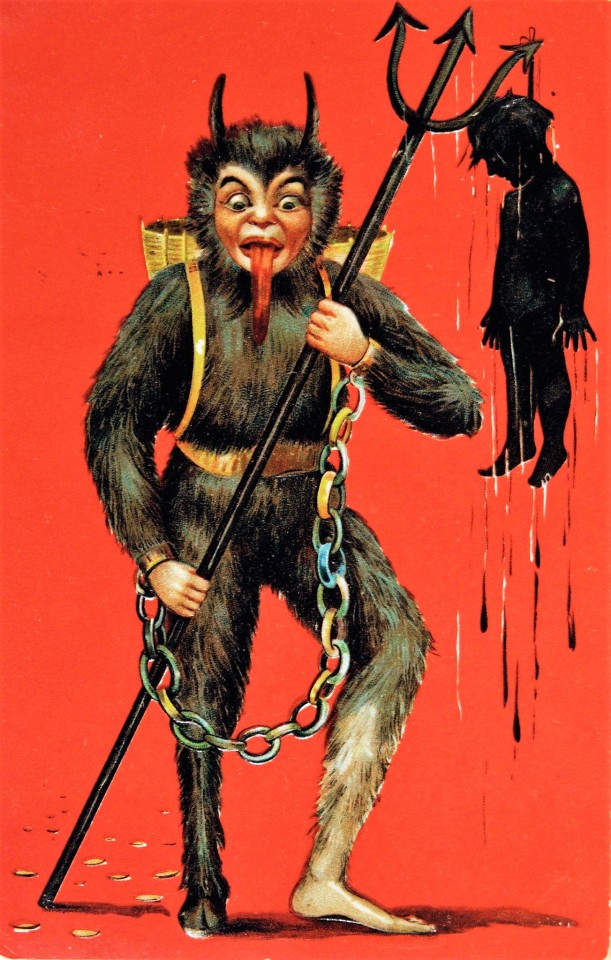
Greetings from Krampus
#krampus#krampus art#vintage illustrations#christmas art#christmas folklore#alpine folklore#krampusnacht#germanic folklore#advent season#supernatural#devil#pagan#greetings from krampus#19th century art#1910s
712 notes
·
View notes
Text

Number 3 in my Christmas Folklore series is Jólakötturinn, the Yule Cat! This adorable beast lurks the snowy countryside and devours those who haven't received new clothes for Christmas... A little incentive for those wool farmers to wrap it up in time for the season. Personally, I think we should use the threat of a man eating cat to complete our tasks a little more often. 👍🎄
He will be on my Etsy later this week
For more of my work, or to snatch a print/sticker come visit me here: https://linktr.ee/spookymoosestudio
139 notes
·
View notes
Text
I recently stumbled upon the Instagram/Tumblr account of "Mister Sam Shearon", a macabre photo-realistic artist who is known to have recently illustrated various books about monsters and supernatural beings from the folklore of various USA states.
He notably did for (two Christmases in a row apparently?) a series of creepy Christmas cards called "Merry Macabre"
Some are actual creepy folkloric creatures and legendary monsters from Christmas beliefs. Such as the Nuuttipukki...
instagram
... the Belsnickel...
instagram
... or the Schnabelperchten:
instagram
Other times he simply took regular Christmas figures and made them creepier, from the Ghosts of A Christmas Carol...
instagram
To "Santa Claws".
instagram
But the reason I make a post about this is because he also did his version of Andersen's Snow Queen, which you can check here if you want:
instagram
#links#instagram#snow queen#dark fairytale#fairytale horror#creepy christmas#merry macabre#macabre winter#christmas horror#a christmas carol#christmas folklore#Instagram
10 notes
·
View notes
Text
I have an idea for a Christmas themed magical girl series.
Santa Claus is kidnapped so Mrs. Claus grants a group of girls magical powers to save him.
Anastasia-Of Russian descent, becomes Snow Maiden, based off of Snegurochka, her colors are blue and white/silver, she represents Christmas snow
Lucia-Of Swedish descent, based off of Saint Lucy her colors are white and red, she represents the Light of Christmas
Sabine-Of Italian descent, becomes the Christmas Witch, based off of La Befana, her colors are red and green, she represents Christmas magic
The villain is Gryla, the Icelandic Christmas ogress. She recruits Krampus, Belsnickel, and maybe an ice wizard, or he’ll be the villain of the next arc.
The key to saving Santa are the gifts from The Twelve Days of Christmas.
What do you guys think? I just thought it was a cute concept, idk for what except my personal head play space. Feel free to add any ideas :)
14 notes
·
View notes
Text
I was trying to look around to see if I could find some more information about Père Noël in its pre-Americanized incarnation online, but unfortunately most websites share the misinformation that "Père Noël" only existed from the 50s onward and was a French invention... No. [Note: I know books exist folks, but I precisely wanted to do a web research first]

There is only one website that does not share this idea and does identify Père Noël as a typical French figure that was then overtaken by the American Santa Claus, and the most fascinating thing is that it points out (despite previous sources I shared claiming "Père Noël" was first recorded in literature in the mid-19th century, by people describing their youth around the turn of the 18th-19th century) that Père Noël seems to have existed since the Middle-Ages, with texts referring to "Père Noël" or to "Monseigneur Noël". But it does recognize that the Père Noël traditions really boomed in the 19th century and were associated with the bourgeoisie of the time...
The website in question however is mostly focused on the various local, regional incarnations of the gift-giver - because as with many things in France, this tradition is rather a set of various regional and localized specificities that were ultimately synthetized into one entity.
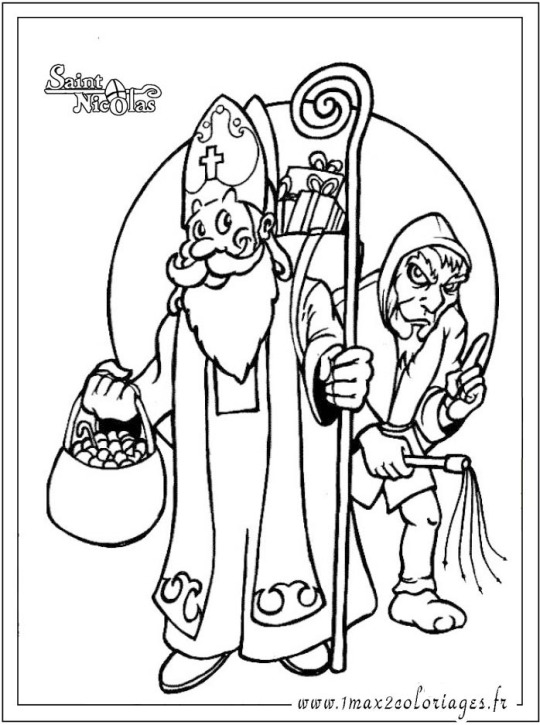


It reminds that in the Lorraine and Alsace region, the Germanic cultures and German influences make it so that Saint Nicholas and Christkindl are still the main gift-givers. In Lorraine it is Saint Nicolas who is most honored (he is after all the saint patron of Lorraine). Appearing in his bishop outfit that makes him look a lot like Santa Claus (thick white beard, large clothes of red and white), every 6th of December he brings gifts and treats to nice children - while naughty children are confronted by his dreaded companion, Père Fouettard dressed in blacks, who beats up with a stick bad children. Saint Nicolas is also still strongly celebrated in the North of France (aka, what is above the Parisian region, because despite what some foreigners believe, Paris is not part of the North).

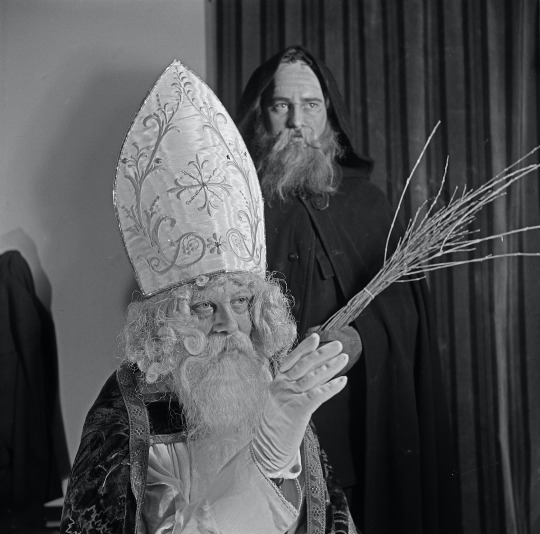
While in Alsace it is the Christkindl that still goes strongly, with Hans Trapp as its own Père Fouettard. The website briefly reminds that Christkindl is an avatar/incarnation of the Child-Christ, or Baby Jesus, that ended up being fused with the 23rd of December Saint, Sainte Lucie (Saint Lucia), resulting in this unique Christmas figure appearing as a woman dressed in white with a crown made of fir branches topped by four candles. It also reminds how Christkindl stays a symbol of Protestant end-of-the-year celebrations, as they pushed the Christkindl figure to oppose and replaced the Catholic celebrations of Saint Nicolas. Finally, there is an Alsace-specific legend that claims Hans Trapp actually originated as an Alsacian lord that tyrannized his people - Hans von Trotha, the 15th century lord of Wissembourg.
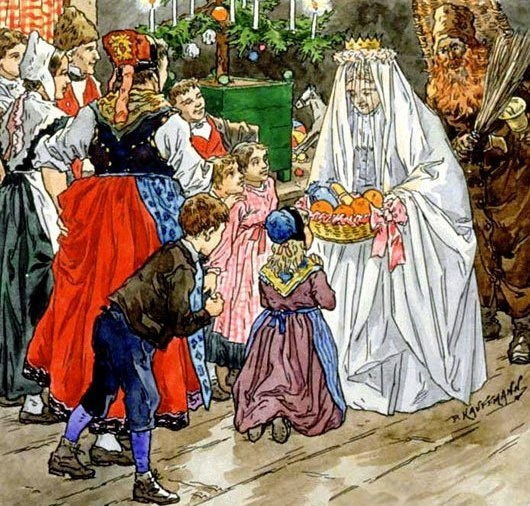

[Given the Alsace region has a lot of website pages about its traditions I'll place here in brackets informations from other websites:
The Christkindl, also written Christkindel or Chriskindla, is a Christian figure that is supposed to be an embodiment of L'Enfant Jésus, Child Jésus (the name comes from Christ-Kindel ; Christus-Kindlein, Christus als Kind), but definitively was influenced by Saint Lucia, who is very big in Scandinavia. In fact, Saint Lucia and the Christkindl look a lot like each other - female entities dressed in white with a crown of candles... Though the Christkindl can appear both as an adult woman and as a little girl, and also tends to have white veils. People tend to also find in Christkindl remnants of the Germanic goddess Berchta. No need to tell you that the Christkindl is big in all parts of the world influenced by German culture - Germany, Austria, northern Italy, Croatia, Slovenia, Switzerland, Czech Republic, and even some parts of Brazil, the ones where there was strong German imigration.
The Christkindl appeared in the 16th century with the Protestant Reform. Up until this point the day of Saint Nicolas was a very big thing in Alsace - saint-patron of school students, he offered good children mandarines and "manala" (a brioche in shape of a child). But the Protestants did not agree with this (Protestants were known to strongly dislike saints in general), and so they replaced the saint with the Christic figure of Christkindl, while keeping Père Fouettard/Hans Trapp (whose job was to threaten with stern lectures naughty children... or take them in a bag to abandon them in the deep dark woods). The change occured over the 16th century, from 1530-1536 (last mentions of Saint Nicolas in Alsace) to 1570 (first mention of Christkindl, when the Klausemärik was replaced by Christkindelmärk). In fact, Christkindl still has some Saint Nicolas traits - she also goes around with a donkey, named Peckeresel, which carries two bags, one for the treats (mandarines and bredalas), one for the whips. People left hay or carrots for the donkey to eat by the front door. Pastor Johannes Flinner made a strong public attack against saint Nicolas in Strasbourg during the "cultural transition", by pointing out that distributing gifts to all should be the prerogative of the Christ and no one else.
During the 20th century the Christkindl lost popularity in Alsace (jee, I wonder why France would like to bury Germanic traditions in the century of World War II) - but it returned in the traditions from the 1990s onward.
Fascinatingly, despite being supposedly a Christ-figure of an angel, the Christkindl, or White Lady, is also frequently called in alsace, a "fée", a fairy, la fée de Noël, the Christmas fairy. It doesn't help that she sometimes carry around a wand with a star at the tip, that is strikingly reminding of the stereotypical fairy-wand. Another irony of fate - despite the Christkindl being brought over to replace Saint Nicolas, the two currently still coexist in Alsace thanks to people not wanting to abandon the good old bishop. A third fun fact: originally the Christkindl could be played as much by women as by men, due to being a truly androgynous entity. From the 16th century onward, the Saint Nicolas celebrations were replaced in Alsace by parades of teenagers of both sexes dressed in white, going from door to door to give gifts and sing Christmas songs. However you can't have teenage boys and girls go around late at night without getting some problems... And those "Saint Nicolas hook-ups" were a real problem in Alsace, you have records from the 17th and 18th centuries pointing out how authorities have to try to refrain all the Christkindl from... well you know.]
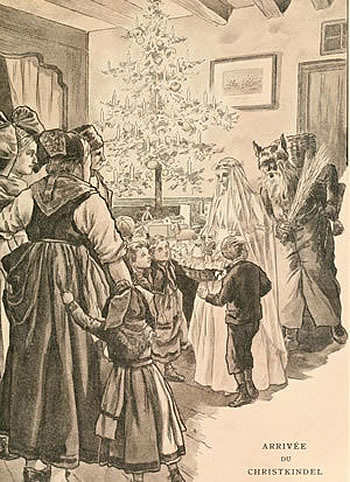


The next entity presented is the famous Pays Basque character of Olentzero, whose appearance is that of a coal-man. Well a bizarre coal man - he has a bag filled with coal in one hand, a sickle in the other, a large beard on his face and a béret on his head. According to the Basque-version of the Nativity lore, he lived at the top of the mountains but saw in the sky the announcement of the birth of Kixmi (Basque name for Jésus), and he descended from his mountains to announce the good news. While he is the gift-giver of Pays Basque, leaving gifts for children in the night between the 24th and 25th of December, entering in the house by the chimney ; he is also a bogeyman figure, as he was a scary-looking man who was said to take away in a bag naughty children. As with everything Basque, Olentzero is actually a pre-Christian figure, as the very name of the character is related to the "pagan" winter solstice celebrations of the old Basque religion.
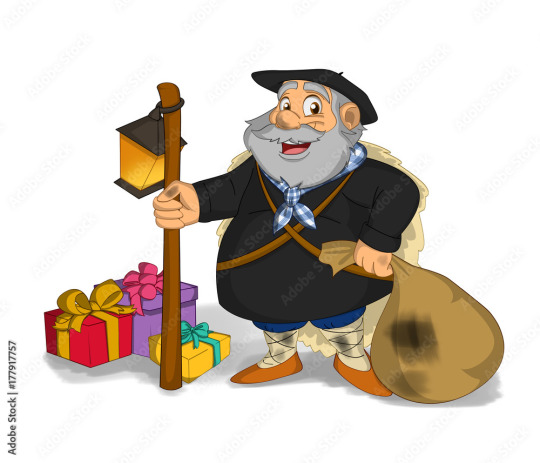
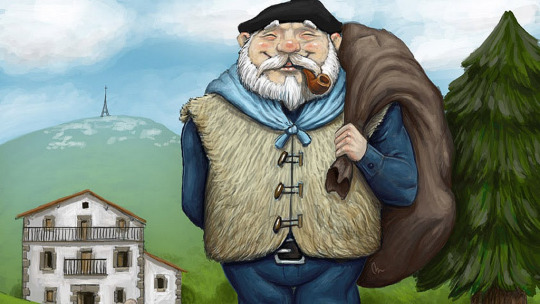
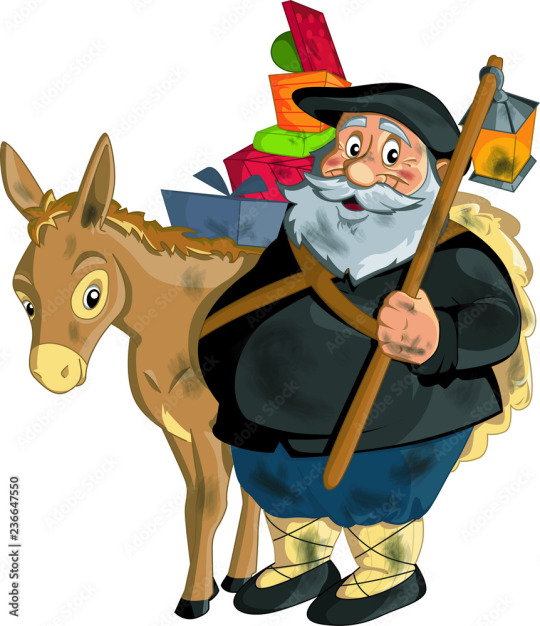
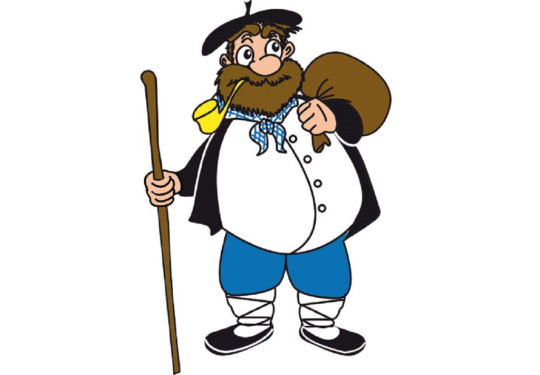
[Again, time to bring some more information from other websites to make sure I give a more complete portrait:
Long story short, because the Basque folklore is very well documented and I can't spend too much time on this, the Olentzero (or Olentzaro, Orentzaro, Omentzaro, Orantzaro...) is at the same time the Basque name for Christmas and the Basque figure of the coal-man that brings gifts during Christmas. He is supposed to be a grotesque character - rude, fat, dirty, gluttonous, his face blackened by soot, with worn-out clothes... He is basically a caricature of mountain-men and forest-men. Sometimes he is even given monstrous traits such as "having as many eyes as there are days in the year, plus one" - which is reminding of a French being of the New Year folklore called L'Homme aux Nez who also has as many noses as there are days in the year...He typically holds branches of gorse in one hand and a sickle in the other.
He comes down from the mountains, enters houses by chimneys, goes into the kitchen once everybody goes to sleep to eat all leftover food, and he warms himself by the fire - either you had to leave a log burning just for him, either he used the flames of the fire to burn his gorse branches. In fact, "olentzero" was also the name of a special log that was left bruning in the fireplace from Christmas to the 1st or 6th of January. This theme of the "coal man" of winter or the burning of branches all answers to a deep motif of bringing back light and heat in the heart of the cold and the dark. Him holding a sickle has made people draw parallel between him and the figure of Saturn/Kronos.
In fact, there is an old tradition, long before the Olentzero was embodied by a disguised man or by a mannequin paraded through the villages, to embody the character simply by the sickle. The sickle hanged by the chimney, as a threat to all disobedient children, to all lying children, and to all children that refused to go to bed. Another symbol of the Olentzero, outside of the sickle and the coal-sack, is a wine-bag or wine-bottle that he carries around, because to add to the grotesque he is also a drunkard, and according to stories it is because he gets often drunk that his wife regularly beats him. (Because yes the Olentzero has a wife, a character named Mari Domingi and who is typically depicted wearing a medieval regional outfit). However it seems that all this grotesqueness is simply due to the Olentzero being a character from the old Basque mythology that got Christianized - think of how the Dagda of Celtic mythology also got more buffoonish/clownesque/grotesque as time passed. We do know that the roots and origins of the character lie in the valley of Bidassoa...)
Today gone is the creepy bogeyman and grotesque glutton ; the Olentzero has evolved into a kinder, nicer, cleaner incarnation that is closer to the Père Noël traditions. For example he now parades through streets during the day, riding a horse (pottok) or by foot, giving children candies and sweets (including fake-coal actually made of sugar) ; and the legend claims he goes down from the mountain to offer coal and wood-logs to the poor families that can't afford fuel for their fire]


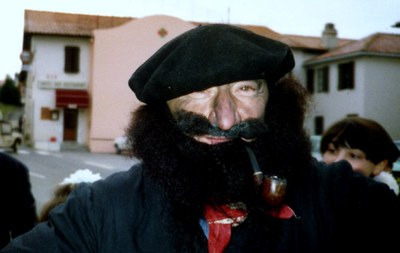

And finally, we find back our good old Père Janvier! Here we have most of the same info as previous. Père Janvier was a Bourgogne character, most present in the Morvan and Nivernais regions up until the 1930s. He brings gifts in the night between the 31st of December and the 1st of January by going through the chimney - chimney which must be decorated with holy and mistletoe. Père Janvier (Father January) typically looks like a skinny old man with a long white beard, dressed in a brown monk-like robe, and he is usually bent due to wearing on his back a heavy wicker basket filled with toys. And he too has for companion the Père Fouettard.
Most interestingly, the website mentions "Père Janvier variations" across France, most notably the Savoie character of Père Chalande, and the Normandie character of Barbassioné.


More information from other website. Le Père Chalande (or Papa Chalande, Daddy Chalande) was indeed a figure of the Savoie region, but also of the Dauphiné, and he was also present in Geneva. Martyne Perrot, in her book "Faut-il croire au Père Noël? Idées reçues sur Noël" even lists the area of action of this figure as: Savoie, Suisse romande, Bresse, Forez, Ardèche, Gard, Lozère and Hérault. He is basically identical to Père Noël because "Chalande" is just an old word for "Noël" (Christmas) in the regional language known as arpitan.
There was a traditional song that went as such: Chalande est venu / Son chapeau pointu / Sa barbe de paille / Cassons les anailles (noisettes) / Mangeons du pain blanc / Jusqu’à Nouvel An. / Il monte dans sa chambre / Il trouve une orange / Il la pluche / Il la mange / On l’appelle le petit gourmand. / Il descend les escaliers / Il se casse le bout du nez / Il va chez le cordonnier / Se faire mettre une pièce au nez / Quand il est malade / Il mange de la salade / Quand il est guéri / Il mange des souris/ Toutes pourries !
I can't translate the full song, but it refers to various traditions. For example leaving an orange for Père Chalande ; Père Chalande wearing a "beard of straw and a pointy hat" (leftovers of Saint Nicolas, especially the pointy hat) ; Père Chalande giving "anailles" (walnuts) to children ; and the habit of placing inside the Christmas log (real log of the fire) chestnuts, so that the burning of the Christmas log doubled as the cooking of the wintery treats. Raymond Christinger wrote in 1965, in a set of research about Geneva folklore, an article studying the character of Chalande, if you know how to read French: here.
While doing Chalande research I stumbled upon a Swiss theory brought forward by a journalist named Bernard Léchot - I don't know how accurate this is when it comes to actual evolution of Christmas figures, but here it is. According to him, the Christmas archetype of the "Old Man" actually comes 18th century Germany. In this era of rationalism, the German Protestant landgraves decided to introduce some laicity to their country, and so cut-off all characters close to Christianity from their Christmas celebrations (from Saint Nicholas to Christkindl). As a result, pagan figures returned, including the Old Man in the shape of Weihnachtsmann. Which then spread to other European countries, each land creating its variation: Bonhomme Noël in France, Father Christmas in England, Père Chalande in Savoie.
As for the Barbassioné of Normandie, I found nothing about him. As in every says it is the Normandie name of Père Noël, but he doesn't have any specific thing to his character.

To conclude, I will link you to a page documenting a Père Noël/Christmas beings exposition that collected various visuals of the history of the Christmas gift-givers through time, right here.
And through it you will see the evolution from the "Scandinavian ancestors" (Thor and Odin) and Saint Nicolas (celebrated in Germanic countries and the Alsace region), to the American Santa Claus and the British "Old Father Christmas", passing by the Germanic Knecht Ruprecht, the also Germanic Weihnachtsmann, the Christinkindel (of Germany, Belgium and Alsace), the Jultomte of Sweden, and the Enfant Jésus/Child-Jesus of France and Italy...
Without forgetting the French Bonhomme Noël, the Italian Befana, the regional ancestors of Père Noël (Tante Arie, Père Chalande, or the Breton Ted Nedelec), the Russian Ded Moroz, and Mère Noël (Mother Christmas)... With additional sections about Santa Claus in advertisements, the theme of "outlaw Father Christmas", Père Noël during the World Wars, and more...
#french folklore#father christmas#père noël#saint nicolas#christkindl#père chalande#père janvier#christmas folklore#olentzero#basque folklore#hans trapp#père fouettard#christmas art#santa claus#christmas
15 notes
·
View notes
Text

A Christmas gift for someone who loves mythical himbos
12 notes
·
View notes
Text
RTD missed an opportunity with "The Church on Ruby Road"
When he made the "baddies" of the episode Goblins (since those have deeply antisemitic overtones, especially with modern associations thanks to a certain fantasy franchise written by a certain TERF).
I mean, if he wanted to go all "magic and fairy tales and folklore," Christmas traditions already have plenty of child-eating monsters associated with the holiday.
The Witch from Hansel and Gretel, who lives in a Gingerbread House and Eats children abandoned by their parents, is right there.
There's also the giant Yule Cat from Iceland (link goes to Wikipedia), [and one conversation I had online, 21 years ago, with a person from Germany about a darker version of Pelznichol, where the naughty children would be scooped into the sack and carried away, but I'm getting really frustrated trying to find it again, and I think it's time I give up searching].
8 notes
·
View notes
Text
youtube
Content warning: this is very much the Devil of folklore, and not an impish little red guy. These stories are not suitable for children.
These tales come from The Complete and Original Norwegian Folktales of Asbjørnsen and Moe, in new translations by Simon Roy Hughes and Juergen Hubert, read by Rory of Varietal Lit.
#the devil on christmas eve#christmas eve#german folklore#norse folklore#christmas#the devil#audio#short stories#videos#folklore#christmas folklore#christmas eve folklore#dark christmas#winter folklore#Juergen Hubert#Simon Roy Hughes#Varietal Lit#Youtube#the woemother#The Complete and Original Norwegian Folktales of Asbjørnsen and Moe#dark winter
7 notes
·
View notes
Text

Krampus says, "I'll be seeing you next year!"
#krampus#krampusnacht#german folklore#christmas tales#christmas folklore#winter solstice#st nicholas#st nick#saint nicholas
7 notes
·
View notes
Text

Heya, friends! I'm going to do a livestream Tuesday evening to show off the new wooden wall-mounted Santa's Workshop DisPlayset, show how I put one together, and answer questions about the project, the Christmas characters, whatever y'all are keen to ask. I hope you'll join me!
youtube
#christmas#Santa Claus#Handcrafted#Arts and Crafts#Christmas Folklore#Christmas Legends#Process#Livestreams#Youtube
54 notes
·
View notes
Photo

Got my horns on and my juniper wreath, wishing everyone a lovely Krampusnacht!
#krampus#krampusnacht#old world christmas traditions#old world christmas#christmas#weihnachtskarten#weihnachtszeit#not done yet but close enough!#digital art#illustration#folklore#christmas folklore
59 notes
·
View notes
Text
Krampus: The Dark Shadow of Winter
By: Christina McCarthy

While many figures in pagan & witch folklore are shrouded in layers of mystery, some stand out as a little stranger than the others. The more I dig to uncover the true nature of Krampus, the more an ethereal snowy mist seems to gather, further obscuring him into the realm of whimsical Yuletide mythology. Perhaps this is how he’s come to inhabit such a unique place in the psyche of modern people around the world.
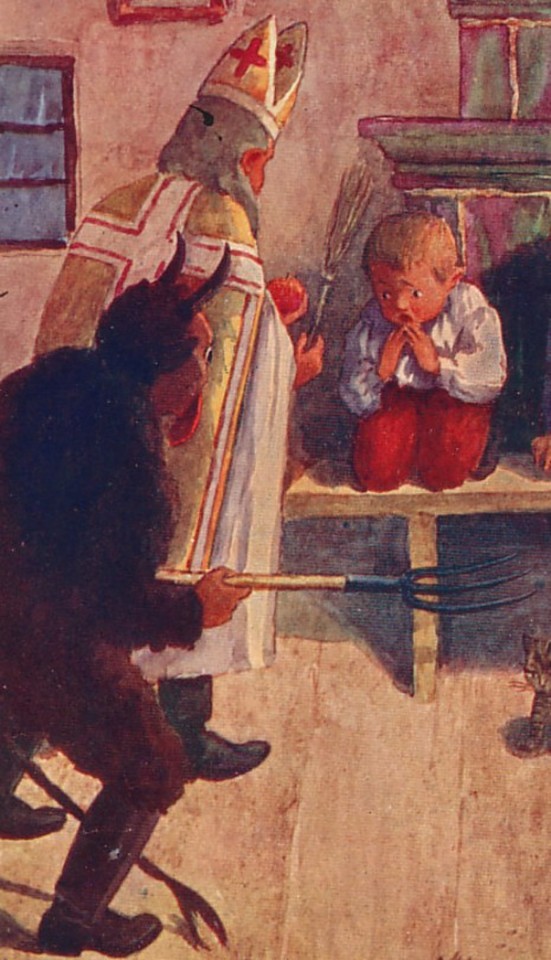
There is debate about how & when the Krampus legend came into being. Some say he’s a sort of pre-Christian deity, the son of Hel, Norse goddess of the Underworld, but evidence for this theory is nonexistent and appears to be a very modern addition to Krampus lore. Other sources say his festival in Germany and throughout Alpine Europe started only a few hundred years ago, a now faded older tradition from pre-Christian Germanic paganism adopted into its modern form by the Catholic church to subdue pagan influences around midwinter. Some classic depictions include chains, to show the power of the Christian god over the “devil”.

This famous depiction shows his one cloven hoof and one clawed bear foot.
Images like these, often featuring poems and season's greetings, come from Krampuskarten, or Krampus cards, often whimsical and humorous greeting & post cards which were exchanged around the holidays, starting in the 19th century. He is often depicted mischievously pursuing beautiful women in a Cupid-like fashion, punishing and chasing weeping children, and accompanying St. Nicholas.
His name appears to come from a combination of a Middle German word, “kralle”, meaning “claw”, and a Bavarian word “krampn” meaning dead, shriveled, or lifeless, connecting him with death mysteries. He is depicted as an often hairy, black or brown, therianthropic beast, part man, part goat, with cloven hooves, reminiscent of the satyrs of Greek mythology. He's also commonly shown with sharp fangs, a red lolling tongue, large bulging eyes, and a single clawed bear foot. There are other regional variations of this spirit, with similar features & mythic function - Knecht Rubrecht and Belsnickel in Germany, Schmutzli in Switzerland, Bartel in Austria, Zwarte Piet or "Black Pete" farther west, and many other midwinter demons. There's even a feminine version - the goddess Perchta lives on today through a similar tradition, Perchtenlauf, where the "ugly" and "beautiful" Perchte or Percht, her hoard of Krampus-like spirits, stage a mock battle in the streets as perhaps a symbolic battle between death and life occurring at midwinter. Some consider this to be a precursor to modern Krampuslauf celebrations, yet the Perchta tradition continues to exist alongside Krampus today.
The widespread prevalence of such similar traditions gives rise to the theory of a class of spirits like Krampus whose names and specific lore vary by local region.

This map shows Alpine Europe - the highlighted area shows the location of the Alps, but of course the Krampus tradition stretches beyond the exact borders shown.
Map source: https://alpshiking.swisshikingvacations.com/where-are-the-alps/
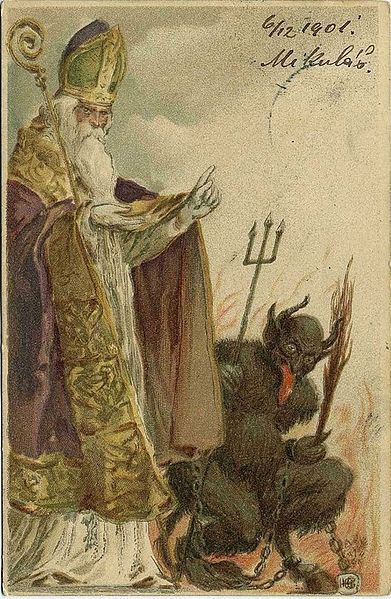
Regardless of his origin, today Krampus strikes a cheerful holiday fright into the hearts of children and adults alike. It’s said that he punishes the children on St. Nick’s naughty list, whipping them with a bundle of birch switches called a "ruten bundle" or sometimes a whip, or kidnapping them in a sack or basket on the eve of St. Nick’s feast day. The punishment is said to fit the crime - the lightest sentence being handed a single birch stick, as if a reminder of which path to choose, and the naughtiest children being dragged to hell or even drowned or eaten by Krampus! Instead of the Christmas Devil's lumps of coal and harsh sentences, good children would find little gifts filling their shoes from the jovial Saint Nicholas, who is often depicted dressed as a bishop with a golden ceremonial staff as pictured above. Sources below have more information about St. Nick if you want to learn more about the minor saint we now call Santa Claus!

In Germanic Europe, holiday festivities in December are first heralded by Krampusnacht, meaning “Krampus Night”, and Krampuslauf, the “Krampus Run”, where revelers dress up in extensive costumes with furs, masks, and horns to run the streets and terrify the townsfolk, inspiring Yuletide nightmares of the Christmas Devil.
This practice may have connection to the pervasive European myth of the Wild Hunt, where dark forces - often depicted as a hunter on horseback and his hounds, among other dark pagan imagery - parade through the skies around midwinter, carrying the souls of mortals over wintery skies to the afterlife. Both Krampuslauf and the Wild Hunt may partly be reminiscent of an ancient cleansing ritual where disguised townsfolk would run the streets, ringing bells and perhaps rattling Krampus's chains, acting as a hellish hoard to scare away unwelcome spirits. To extend the conjecture even farther, some draw a link from Krampus to the witches' horned god, due to his similarity to "wild man" therianthropic figures such as Pan, Cernunnos, and Herne.
Once the children have been sufficiently frightened into another year of their best behavior, the Krampuses traditionally drink alcohol in celebration. The drink of choice, for this after party and for offerings to Krampus, is schnapps. The Krampuslauf tradition is believed to be around 500 years old, and while many attempts to quell these celebrations have been enacted by oppressive forces, from the Catholic church throughout several centuries, to the Christian Social Party of Austria with their famous propaganda pamphlet titled "Krampus Is an Evil Man", to the Nazi Party, the Krampus run is alive and growing today.

From a Krampus celebration in Austria.
One of the most famous festivals takes place in Munich, Germany. Among their famous Christmas marketplace, filled with glittering lights and symbols of Catholic advent, caroling, traditional treats, and the glow of a modern city, Krampuses can be found running around giving folks a chilling holiday scare, reminding them of a time gone by when the fear of winter’s darkness kept everyone warm and safe inside their homes on the eve of December 5th.
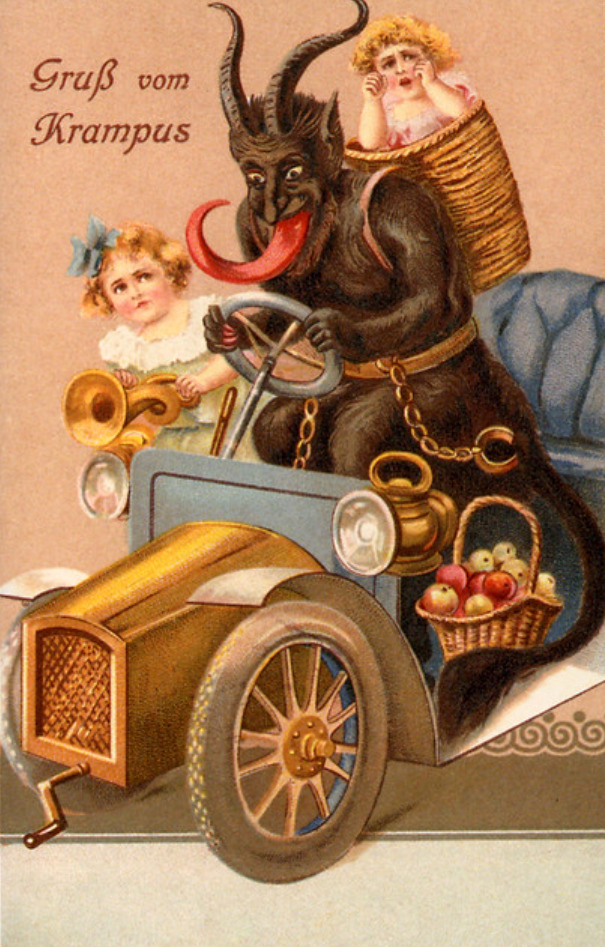
Krampus in a getaway car! We often think of a tradition like this as distant history, so seeing a depiction made during a period of industrialization is a little mind bending!
I personally believe the modern resurgence of Krampus is related to a collective yearning, whether conscious or unconscious, to honor the darkness of the season. What’s become a heavily Christianized (and commercialized) “holiday season” of constant flashing lights and warm familial celebrations, was once more widely regarded as a time of death, darkness, and difficulty. In the depth of winter, when resources and warmth were scarce & daily life was focused on enduring the season, celebrations of the sun were an ode to survival and hope that life would return to the earth again. Krampus represents this inescapable reality of the darkness and hopelessness we experience when the sun is at its weakest, when all the earth holds its breath, silently praying for deliverance from night’s bitter shadows.
Sources:
Note: I'm loosely using Chicago style format, unless there isn't enough information to bother, in which case I will usually just post the link.
🕯️Bustamonte, S. (2018) Krampus Spaß, The Wild Hunt: Pagan News and Perspectives. Available at: https://wildhunt.org/2018/12/the-murky-origin-of-the-krampus.html.
This was an especially rich resource! It contained a lot of detailed information that I’ve never heard before, but most of the new content presented, I was able to verify by looking at other sources. It also lists a book source that seems interesting - books aren’t foolproof, their information should still be verified, but a website listing a printed source is a good sign the information is likely to be correct!
🕯️Krampus. https://brickthology.com/category/banishing/
This was an interesting resource with a wealth of information, which was not sourced and the author seemed to be a random unidentified person, so I still cross referenced the information. This person seemed to have a good working knowledge of the cultural traditions which may be from personal experience, and that kind of information is important in research about regional folklore.
🕯️ https://www.britannica.com/topic/Krampus
🕯️https://www.britannica.com/biography/Saint-Nicholas
For most projects, I use simple pages like these as a starting point for a quick summary of basic information. Brittanica has been around a long time, and I know the information on their site is usually accurate. I still cross-verify the information to make sure there aren’t any inconsistencies.
🕯️Christmas Market at Marienplatz: The Magic of the Christmas Season. Simply Munich. Available at: https://www.munich.travel/en/pois/markets-festivals/christmas-market-marienplatz.
I had some prior knowledge that one of the most popular Krampus Runs takes place in Munich, so I sought out an official Munich website to get their version of the information. What I found was context surrounding Krampus, seating him firmly in modern German customs, and that helps bring mythology to life.
🕯️Krampus, the Christmas Devil of Alpine Europe. The German Way & More. Available at: https://www.german-way.com/krampus-the-christmas-devil-of-alpine-europe/.
I didn’t strictly use this source in this blog post, but I found it to be a credible source that goes further into detail about regional Krampus traditions, containing photos, videos, and further links on related topics. I like to provide sources like this in my bibliographies for people to learn more than what I wanted to cover in the post.
🕯️Perchtenlaufen. https://en.wikipedia.org/wiki/Perchtenlaufen
That's right, this is a wikipedia link! Sure, wikipedia can be unreliable. As long as you're checking the information with other sources, there's nothing wrong with using it as a starting point to break into information you're not familiar with.
All photos with sources not listed are under public domain.
#krampus#krampusnacht#blessed yule#yule log#christmas#christmas traditions#midwinter#winter solstice#modern paganism#pagan witch#folklore#germanic folklore#norse folklore#norse#krampus run#christmas devil#st nicholas#christmas folklore#krampuslauf#paganism#witchcraft#witches of tumblr#germanic paganism#folk magic
49 notes
·
View notes
Text

Winter Waltz
Scary folklore figures are the only kind of holiday art you’ll ever get out of me
#repost bc i forgot my watermark OOPS#krampus#krampus art#frau perchta#perchta#perchten#winter art#christmas folklore#fantasy art#frau perchta art#digital art#artists on tumblr#dark winter#character design#art#ratt teeth art
44 notes
·
View notes
Text

Krampus Brooch
6 notes
·
View notes
